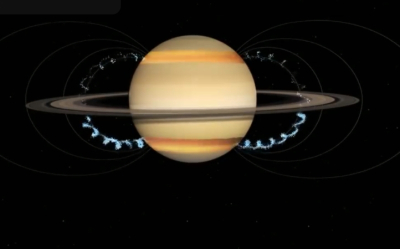SPACE — Saturn’s rings are continuing to disappear, and we don’t know how much longer they will be around. Since the 1980s, astronomers have known that the gas giant’s inner ice ring is continuously eroding into its upper atmosphere.
Torrential rain from melting Saturn’s rings continues at very high rates. Water as much as an Olympic standard swimming pool rains down on Saturn every day. However, how quickly the iconic ring system shrinks and disappears remains an open question among astronomers.
Fortunately, NASA’s James Webb Space Telescope (JWST or Webb) will soon be investigating an interesting phenomenon found on Saturn, which is still close to Earth. It’s worth noting that Webb’s instruments are powerful and have peered into galaxies far from the early universe, which are billions of light years away from Earth.
Scroll to read
Scroll to read
“We are still trying to figure out how fast they are eroding,” said James O’Donoghue, a planetary scientist at the Japan Aerospace Exploration Agency in a statement on Monday, April 17, 2023.
O’Donoghue will lead a new effort to find out how long Saturn’s rings last. “Right now, research shows the rings will only be part of Saturn for another few hundred million years.”
To better estimate the age of Saturn’s iconic rings, Webb and the Keck Observatory in Hawaii will be part of a long-term observation campaign to study the planet. The telescope will help monitor how the ‘ring rain’ phenomenon fluctuates over a full season on the gas giant. It is known, 1 Saturn year is equal to 7 Earth years because of its orbit far from the sun.
Astronomers expect exciting data from the program, as previous studies have shown large amounts of ring material to be constantly melting and falling onto Saturn. For example, data sent by NASA’s Cassini spacecraft has revealed between 880 pounds (400 kg) and 6,000 pounds (2,800 kg) of hail pouring onto the planet every second and heating its upper atmosphere. Cassini glided through the gap between Saturn and its rings 22 times in 2017.
At that rate, Saturn’s rings will likely disappear in about 300 million years. Even though it seems like a long time, the defense of the ring that keeps getting smaller can weaken so that its destruction is relatively faster. Even so, the rate at which ring material rains onto the planet remains largely uncertain.
According to astronomers, the rings could disappear as fast as 100 million years, or maybe last for 1.1 billion years. “Right now, astronomers only have one very broad estimate. We want to do more observations that narrow this range,” O’Donoghue told Space.comlast Wednesday, April 26.
According to current research, space rocks and solar radiation slightly disturb the ring particles and give them such an electric charge that they bind the gas giant’s magnetic field lines. Saturn’s gravity then pulls the ice particles flowing into the planet’s upper atmosphere, but not always at the same speed.
As Saturn goes around the sun in its 29.5 year orbit, it shifts toward it away from the sun, and its rings do the same. This tilt determines how much solar radiation affects the innermost layers of the ring system, where much of it triggers hail. That likely played a role in determining how much material fell onto Saturn.
“We suspect that when the rings are at the edge of the sun, the ring rain will slow down. And when they are tilted toward the sun, the ring rain will increase,” O’Donoghue said.
So his team will use Webb and Hawaii’s Keck Observatory to measure the growing emissions of certain hydrogen molecules in Saturn’s upper atmosphere. These molecular measurements increase when small amounts of material from Saturn’s icy rings fall into its atmosphere. “But shrinks during the abundant ring rains,” said O’Donoghue. Monitoring changes in these hydrogen emissions over a full season on Saturn could help the team determine how much ring material is falling as rain onto the planet.
“The instrument at Keck that we used for this has previously been upgraded, and we haven’t used JWST for this before. So, we’ll be able to forecast ring rain fall better than before.”
When Are Saturn’s Rings Formed?
While the new research will help predict the fate of the rings, astronomers studying Saturn’s world continue the longstanding debate about how and when the planet’s rings were born. Models have shown rings to have been permanent structures around Saturn as early as 4.5 billion years ago, which is the same as the age of the solar system. However, data from the Cassini spacecraft indicates the ring is much younger, about 10 million to 100 million years old.
The differences arise because older rings are often darker, but Cassini has seen Saturn’s rings bright, hinting at their youth. In 2019, astronomers revisiting the debate suggested that the ring’s heavy rain might be causing the ring’s face to look younger. They stick to the original idea that the rings are as old as the solar system.
“I think it would be very interesting if the rings lived only 100 million years or so, and they are (already) billions of years old. That means we evolved just in time to see them before they disappeared,” O’Donoghue said. Source: Space.com
“).attr(
type: ‘text/javascript’,
src: ‘
).prependTo(“head”);
if ($(“.instagram-media”).length > 0)
$(”
2023-05-03 04:37:11
#Saturns #Ring #Disappears #Webb #Telescope #Pointed #space


